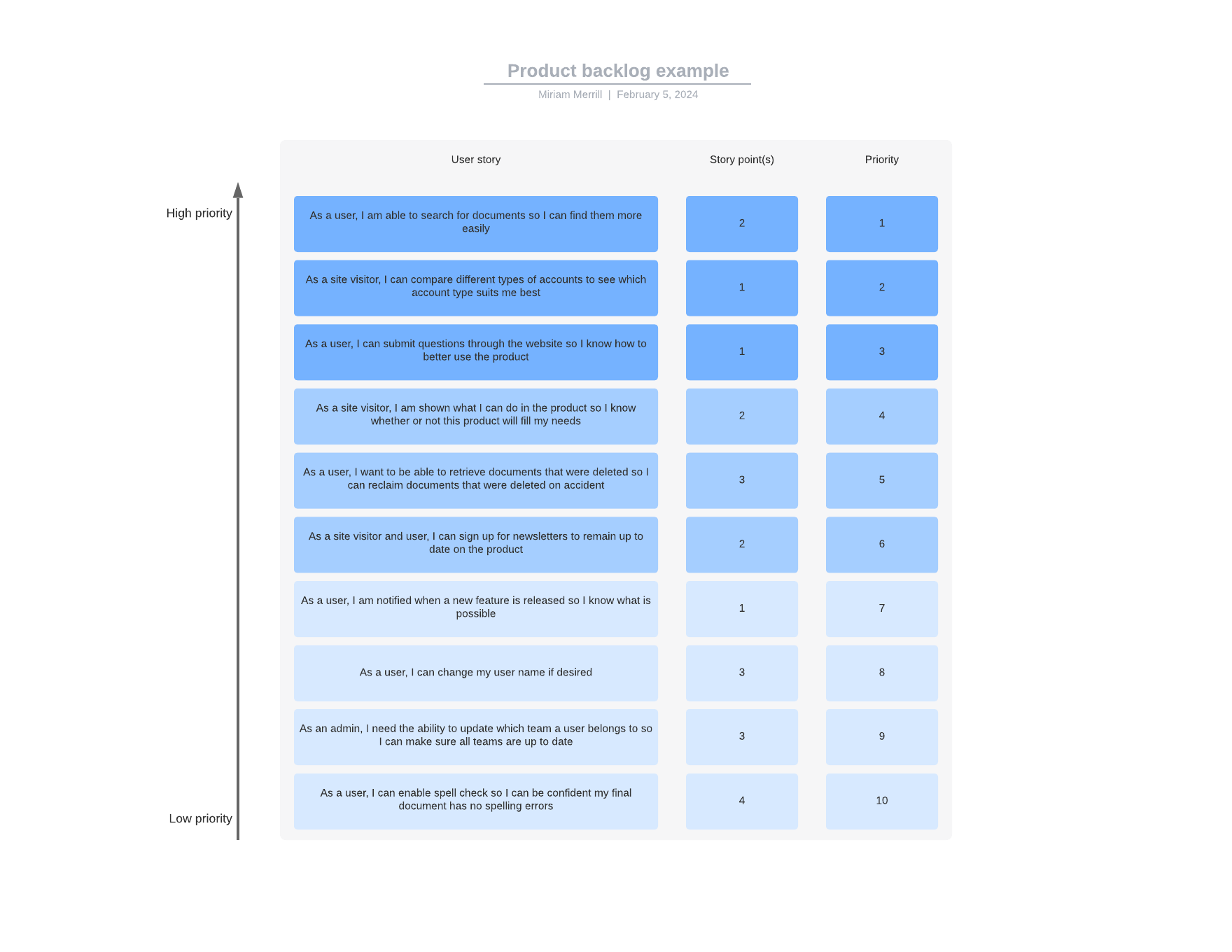
What to do when your product backlog becomes overwhelming
Reading time: about 7 min
Topics:
A product backlog can feel quite a bit like the to-do list involved with maintaining an old home. From big repairs like replacing the roof to weekly duties like mowing the lawn, no matter how many items you seem to get through on your to-do list, there’s always more to do, and the list is never done.
Similarly, it's easy for product owners or project managers to feel like they’re stuck with a never-ending backlog that demands more and more manpower while becoming increasingly disorganized.
That’s why product backlog management is so important.
A well-prioritized and well-maintained product backlog can improve release planning, streamline development, prevent scope creep, and keep everyone on the same page–leading to better products and fewer headaches.
Learn how to prioritize the tasks in your product backlog to streamline the process for the future and bring peace of mind to everyone involved.
What is product backlog management?
A product backlog outlines all the work a team needs to do to deliver a product. Teams use the product backlog to prioritize the tasks and make sure they are focusing on the right tasks at the right time. But with complex or long-term projects, product backlogs can quickly get, well, backlogged.
That’s where product backlog management comes in.
Product backlog management ensures that the product backlog is well-prioritized, relevant, and clear so the team can work efficiently and effectively. Product owners are typically responsible for product backlog management, which involves ongoing monitoring and adjustments to determine what the team will work on now, later, or not at all.
Common mistakes with product backlog management
A product backlog is a necessity, but occasionally, product backlog management is so poor that work gets delayed, the wrong tasks are prioritized, and teams can even start to ignore the backlog altogether. That’s a massive issue that halts the systematic progression and natural evolution of a product.
Take a look at the common product backlog management mistakes that lead to product backlog chaos.
Unclear prioritization
Priorities need to be defined by stakeholders ahead of time so that items can be objectively grouped into levels of urgency. It’s important these definitions are written down so that there’s no confusion: the highest-impact and most urgent items on the backlog must be addressed first.
When defining prioritization, address:
- Priority for customers
- Ease of implementation
- Relationships between tasks
- Resource constraints
- Business value
The weight of each of these factors contributes to the overall importance of an item and determines its placement of priority in the backlog.
Irrelevant items
A backlog isn’t the place to throw in just any idea. That leads to a cluttered, disorganized backlog. Instead, every item in the backlog should be a purposeful step toward the ultimate goal of the product.
This goal is referred to as the product vision, and if your team doesn’t have one, there’s no way to have an organized backlog. Develop a clear product vision and make sure that every item in the product backlog points toward achieving that product vision.
Not accounting for dependencies
It’s a minor (and sometimes major) disaster when an urgent, highly impactful item rises to the top of the backlog and the dependencies that need to be implemented first are lower on the backlog. This situation leads to greater disorganization and, ultimately, slower product improvement.
7 tips to help you prioritize an overwhelming product backlog
With a few best practices, it’s easy to groom the backlog down to a manageable length.
Use these techniques for effective product backlog management:
1. Have a clear product vision
We mentioned this briefly above, but it’s worth mentioning it again. The product vision is the North Star to which all tasks should point. This product vision needs to be clearly defined, updated as needed, accessible by everyone at any time, and referred to often. Product managers often provide a product requirements document at the beginning to illustrate the product vision and keep everyone involved working towards the same goal, and it’s an easy barometer to use when determining what goes in a backlog and what can be tossed away.
2. Set guidelines for your backlog
Your business needs to decide individual guidelines that dictate what items will and will not be included in the backlog, as well as what weight to give various factors to determine the order of prioritization. Without these standards in place, prioritization becomes arbitrary.
3. Organize items with prioritization scores
To eliminate bias when addressing prioritization and to determine the most efficient and most strategic approach, it’s smart to use a numerical system that can assist with determining priority.
There are various scoring models that give numerical scores based on factors, such as customer value, implementation costs, and increased revenue; it may take experimenting to determine the best scoring model for your business. The end result, however, should be that your backlog is divided into top priority, medium priority, and longer-term priority.
This strategic approach to organization is a great way to defend and explain the order of tasks in the backlog to stakeholders, teams, and anyone else involved in the product’s evolution.

4. Use a product management tool
A good product management tool can convert the stress and uncertainty of backlog tasks into smaller, actionable tasks. It can help you visually determine dependencies you may not have noticed and can also improve and maintain transparency. A product management tool converts frustration into progress, and that’s more than worth the price of a software subscription.
5. Groom your list often
There are many reasons why an item in the backlog may no longer be necessary: customer needs change, resources change, and priorities shift. It’s important to note that the prioritization score initially assigned to an item won’t necessarily remain the same, and as soon as that score changes, it may move up or down the list in priority.
Without grooming (or refining) the list, however, it’s impossible to keep on top of the most important items. When items become outdated, they should simply be removed from the list. And when items are so low in priority that they won’t be addressed within the next six months, those should also be removed.
6. Create an idea list
Timing is everything. An idea that once seemed irrelevant—such as implementing social distanced delivery options—may suddenly take on new importance overnight. Instead of just throwing away items, move them to an idea list and revisit that idea list occasionally when innovation seems to be lagging.
7. Assign time and development resources
A product management tool can help greatly with this, as it’s easy to see which team member is working on what. But not taking the time to examine available resources when transferring items from the backlog into the current scrum can quickly lead to disaster. Suddenly, one task that seemed relatively simple could end up using all your developers’ time.
You may want to develop a point system that converts manpower hours into points and then determine how many points you have total based on your current resources. If you have two developers coding full-time, an hour of coding time might be represented by one point. If you have 80 points total per sprint, it would be irresponsible to assign items from the backlog worth 400 points each.
Using a point system to establish your team’s velocity is a clearer way to measure the amount of work that can be completed in a sprint and ensure more efficient resource management.
A product backlog is inevitable, but instead of viewing it as a disorganized mess, view it as a list of opportunities. This mindset can help get people excited about where your product is going and can help teams better understand what they’re working towards. Plus, a backlog is the best way to keep the highest priority, biggest impact items front and center.

Once you have your product backlog organized, run an effective sprint planning meeting to get moving on projects.
Learn howAbout Lucidchart
Lucidchart, a cloud-based intelligent diagramming application, is a core component of Lucid Software's Visual Collaboration Suite. This intuitive, cloud-based solution empowers teams to collaborate in real-time to build flowcharts, mockups, UML diagrams, customer journey maps, and more. Lucidchart propels teams forward to build the future faster. Lucid is proud to serve top businesses around the world, including customers such as Google, GE, and NBC Universal, and 99% of the Fortune 500. Lucid partners with industry leaders, including Google, Atlassian, and Microsoft. Since its founding, Lucid has received numerous awards for its products, business, and workplace culture. For more information, visit lucidchart.com.
Related articles
Product differentiation: How to position yourself in the market
If you're running a business in today's crowded market, how do you make your products stand out? Through product differentiation. Discover what product differentiation is, why it's important, what types there are, and how to develop a strategy around it.
Why you need a business analyst on your product development team
In this article, we go over why a business analyst (BA) should be an essential member of any product or software development team. Learn how a good BA can help you harness and tame your company data to better connect with your customers.
How to increase developer productivity
Learn practical strategies to evaluate and enhance developer productivity.
How to develop a project strategy for organizational success
When it comes to project management, quality is more important than quantity. Stop wasting valuable resources—narrow your initiatives down to those that align with your overall company vision. Learn how to align your project strategy and prioritize projects.
